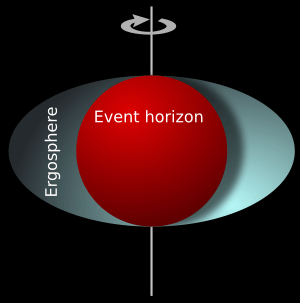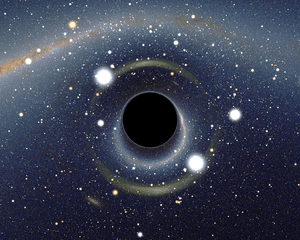Ergosphere

The ergosphere is a region located outside a rotating black hole. Its name is derived from the Greek word ergon, which means “work”. It received this name because it is theoretically possible to extract energy and mass from the black hole in this region. The ergosphere has an oblate spheroidal shape that touches the event horizon at the poles of a rotating black hole and extends to a greater radius at the equator. The equatorial (maximum) radius of an ergosphere corresponds to the Schwarzschild radius of a non-rotating black hole; the polar (minimum) radius can be as little as half the Schwarzschild radius if the black hole is rotating maximally.[1]
Within the ergosphere, spacetime is dragged along in the direction of the rotation of the black hole at a speed that varies with distance from the event horizon, becoming zero at the ergosphere.[2] This process is known as the Lense-Thirring effect or frame-dragging.[3] Because of this dragging effect, objects within the ergosphere could not be stationary with respect to the rest of the universe unless they were to travel faster than the speed of light with respect to local spacetime. A suspended plumb, held stationary outside the ergosphere, will experience infinite/diverging radial pull as it approaches the static limit. At some point it will start to fall, resulting in gravitomagnetically induced spinward motion. Another result of this dragging of space is the existence of negative energies within the ergosphere.
The outer surface of the ergosphere is called the static surface. At the static surface, a particle, moving against the flow of space at the speed of light, is static relative to a distant observer. This is because world lines change from being time-like outside the static limit to being space-like inside it.[4] Outside this surface, space is still dragged but at a lesser rate.
Since the ergosphere is outside the event horizon, it is still possible for objects to escape from the gravitational pull of the black hole. An object can gain energy by entering the black hole’s rotation and then escaping from it, thus taking some of the black hole's energy with it. This process of removing energy from a rotating black hole was proposed by the mathematician Roger Penrose in 1969, and is called the Penrose process.[5] The theoretical maximum of possible energy extraction is 20.7% of the total energy of a rotating black hole. When this energy is removed, the black hole loses its spin and the ergosphere no longer exists. This process is considered a possible explanation for a source of energy of such energetic phenomena as gamma ray bursts.[6] Results from computer models show that the Penrose process is capable of producing the high energy particles that are observed being emitted from quasars and other active galactic nuclei.
The size of the ergosphere, the distance between the ergosurface and the event horizon, is not necessarily proportional to the radius of the event horizon, but rather to the black hole's gravity and angular momentum. A point at the poles does not move, and thus has no angular momentum, while at the equator the distance covered by a point in the black hole within a given time is greater than any other point at the black hole, giving the point at the equator the greatest angular momentum. This difference of angular momentum that extends from the poles to the equator and is reflected over the equator is what gives the ergosphere its oblated shape. If the gravity or the rotation speed increases, the size of the ergosphere increases as well. Conversely, if the rotation speed decreases, the size of ergosphere decreases, too.[7]
References
- ↑ http://physics.ucsd.edu/students/courses/winter2010/physics161/p161.26feb10.pdf - Professor: Kim Griest, Physics 161: Black Holes: Lecture 22: 26 Feb 2010
- ↑ Misner 1973, p.879
- ↑ Darling, David "Lense-Thiring Effect"
- ↑ Misner 1973, p.879
- ↑ Bhat, Manjiri ; Dhurandhar, Sanjeev & Dadhich, Naresh "Energetics of the Kerr-Newman Black Hole by the Penrose Process" January 10, 1985
- ↑ Nagataki, Shigehiro (28 June 2011). "Rotating BHs as Central Engines of Long GRBs: Faster is Better". arXiv. Retrieved 17 September 2013.
- ↑ Visser, Matt (1 December 1997). "Acoustic black holes: horizons, ergospheres, and Hawking radiation". arXiv. Retrieved 8 November 2011.
Further reading
- Chandrasekhar, Subrahmanyan (1999). Mathematical Theory of Black Holes. Oxford University Press. ISBN 0-19-850370-9.
- Misner, Charles; Thorne, Kip S.; Wheeler, John (1973). Gravitation. W. H. Freeman and Company. ISBN 0-7167-0344-0.
External links
| ||||||||||||||||||||||||||||||||||||||||
